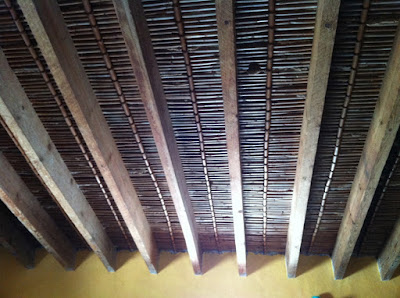You may think total relaxation and laziness have taken over here if nothing is written. You are right of course, but only partly. Here is one of the less fun jobs if you live in an old house with lots of wood in a warm climate: protection of the wood against wood worm, termites etc.
We have a classic Spanish house with a roof that makes Spanish people swoon when they lay their eyes on it, as there aren't many of these roofs left. A roof was made here in the past by placing wooden beams on the walls, put a mat of bamboo-like reeds on top of the beams, apply a layer of clay-cement-like stuff of 5-10 cm, and put the roof tiles on top of that:
As you can see there is quite some wood visible in the open air. And where this is the case some hungry wood worms may abuse the structure for their digestive needs. That is why you can see some tiny holes here and there:

Fortunately these are old holes, there is no live woodworm or termite at this moment. But, an old house is susceptible. That is why I finished the remaining fly-screens the past weeks, so all windows now have a 100% ventilating and 100% insect-proof screen. No woodworm of termite will get into this house any more. Well, not via a window. It's still possible through the front door, that is usually open, even though closed off by a nice chains fly screen. A pregnant woodworm or termite may still get in.
Chemical engineers have found a counter measure: once every 5 years you need to treat your wooden beams with a repellent. Here we bought 5-liter cans with "Matacarcoma": a solvent with permethrin as the active ingredient. It's a "mild" pesticide. Nasty for insects but not very dangerous for mammals. It's also an ingredient of the flee-tick-sandfly drops of the dogs.
As it's not really a baby lotion either, you better use protecting dress, and ventilate well. The stuff stinks. Not the permethrin, but the solvent. Another reason the mosquito screens were finished first, so the windows could be wide open for ventilation and get rid of the stench. I tried to apply the stuff with a brush first. That works okay, as long as you can easily reach the wooden beams. However, we have quite some parts of the roof that are 4+ meters high, where brushing above your head is not fun. So we abuse a Gardena plant spray. Also because you cannot get to the area between beam and roof with a brush. With a spray you can, although you will "atomize" some of the chemicals. A big ventilator helps, but still it is a hell of a job.
Attic, bathroom 1 and 2, woodstove room, library-hallway are done. Still to do: living room, bedroom, and kitchen ceiling.I'm about half way through. Nearly used 3 cans of 5 liters, I think we need 2 more.










